Nestle's ERP Implementation: Problems and Successes
VerifiedAdded on 2023/06/12
|14
|3490
|168
AI Summary
This report evaluates the problem faced by Nestle when they implemented the ERP system. The report highlights the nature of the enterprise system and the process of selection and implementation. The difficulties faced by Nestle in adopting the system and the successful adoption of the enterprise system are also discussed. The success metrics used by Nestle are employee engagement, saving financial resources, conversion rate and technical failures.
Contribute Materials
Your contribution can guide someone’s learning journey. Share your
documents today.
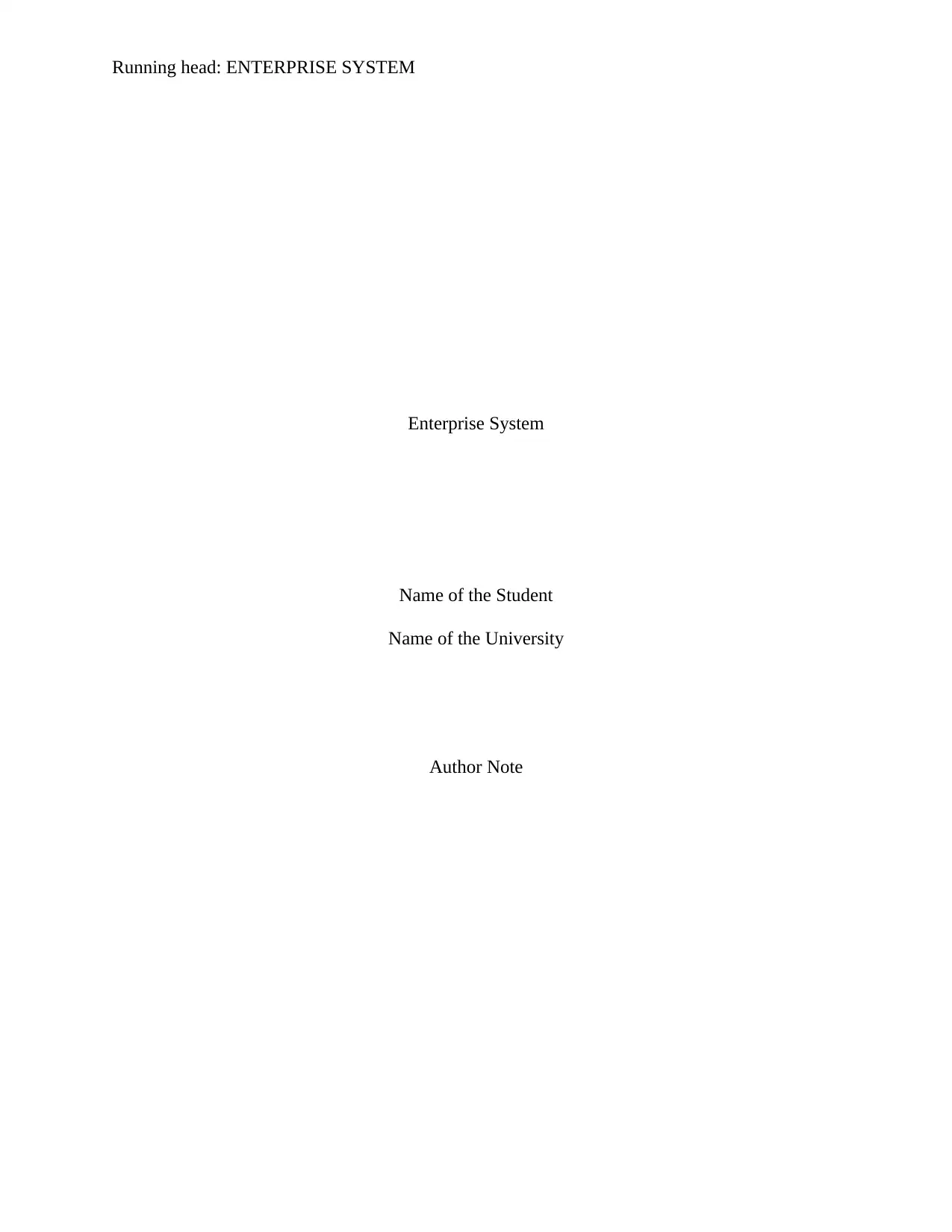
Running head: ENTERPRISE SYSTEM
Enterprise System
Name of the Student
Name of the University
Author Note
Enterprise System
Name of the Student
Name of the University
Author Note
Secure Best Marks with AI Grader
Need help grading? Try our AI Grader for instant feedback on your assignments.
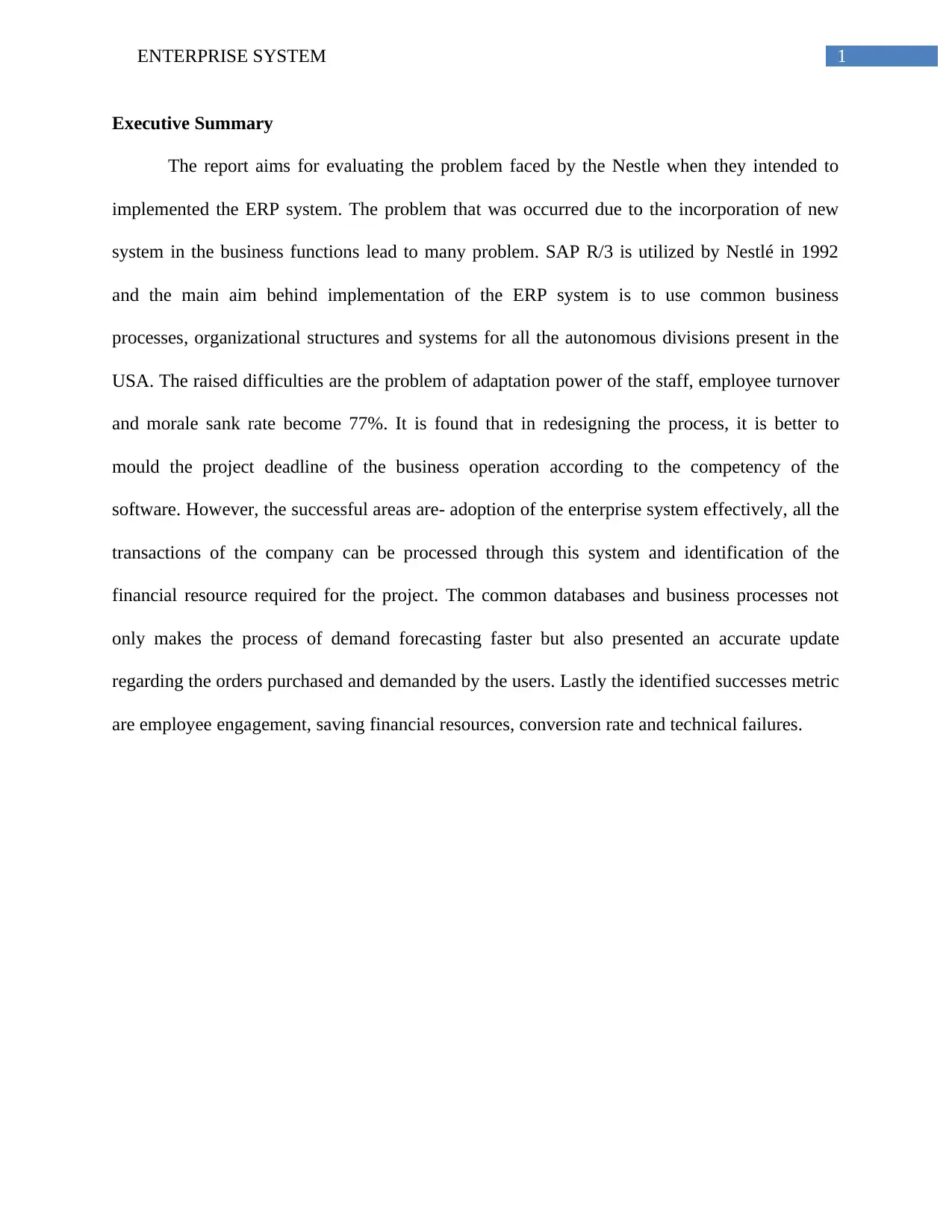
1ENTERPRISE SYSTEM
Executive Summary
The report aims for evaluating the problem faced by the Nestle when they intended to
implemented the ERP system. The problem that was occurred due to the incorporation of new
system in the business functions lead to many problem. SAP R/3 is utilized by Nestlé in 1992
and the main aim behind implementation of the ERP system is to use common business
processes, organizational structures and systems for all the autonomous divisions present in the
USA. The raised difficulties are the problem of adaptation power of the staff, employee turnover
and morale sank rate become 77%. It is found that in redesigning the process, it is better to
mould the project deadline of the business operation according to the competency of the
software. However, the successful areas are- adoption of the enterprise system effectively, all the
transactions of the company can be processed through this system and identification of the
financial resource required for the project. The common databases and business processes not
only makes the process of demand forecasting faster but also presented an accurate update
regarding the orders purchased and demanded by the users. Lastly the identified successes metric
are employee engagement, saving financial resources, conversion rate and technical failures.
Executive Summary
The report aims for evaluating the problem faced by the Nestle when they intended to
implemented the ERP system. The problem that was occurred due to the incorporation of new
system in the business functions lead to many problem. SAP R/3 is utilized by Nestlé in 1992
and the main aim behind implementation of the ERP system is to use common business
processes, organizational structures and systems for all the autonomous divisions present in the
USA. The raised difficulties are the problem of adaptation power of the staff, employee turnover
and morale sank rate become 77%. It is found that in redesigning the process, it is better to
mould the project deadline of the business operation according to the competency of the
software. However, the successful areas are- adoption of the enterprise system effectively, all the
transactions of the company can be processed through this system and identification of the
financial resource required for the project. The common databases and business processes not
only makes the process of demand forecasting faster but also presented an accurate update
regarding the orders purchased and demanded by the users. Lastly the identified successes metric
are employee engagement, saving financial resources, conversion rate and technical failures.
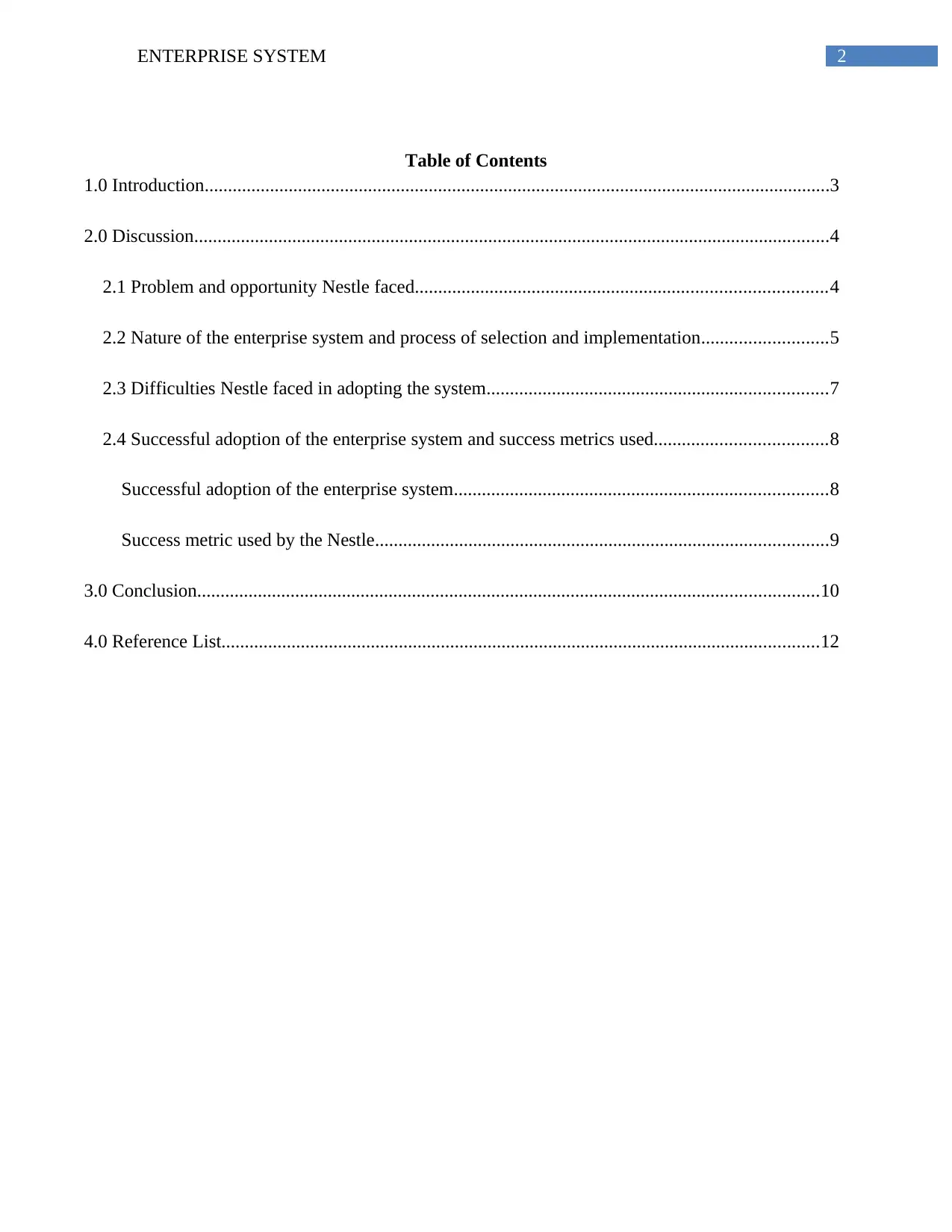
2ENTERPRISE SYSTEM
Table of Contents
1.0 Introduction......................................................................................................................................3
2.0 Discussion........................................................................................................................................4
2.1 Problem and opportunity Nestle faced........................................................................................4
2.2 Nature of the enterprise system and process of selection and implementation...........................5
2.3 Difficulties Nestle faced in adopting the system.........................................................................7
2.4 Successful adoption of the enterprise system and success metrics used.....................................8
Successful adoption of the enterprise system................................................................................8
Success metric used by the Nestle.................................................................................................9
3.0 Conclusion.....................................................................................................................................10
4.0 Reference List................................................................................................................................12
Table of Contents
1.0 Introduction......................................................................................................................................3
2.0 Discussion........................................................................................................................................4
2.1 Problem and opportunity Nestle faced........................................................................................4
2.2 Nature of the enterprise system and process of selection and implementation...........................5
2.3 Difficulties Nestle faced in adopting the system.........................................................................7
2.4 Successful adoption of the enterprise system and success metrics used.....................................8
Successful adoption of the enterprise system................................................................................8
Success metric used by the Nestle.................................................................................................9
3.0 Conclusion.....................................................................................................................................10
4.0 Reference List................................................................................................................................12
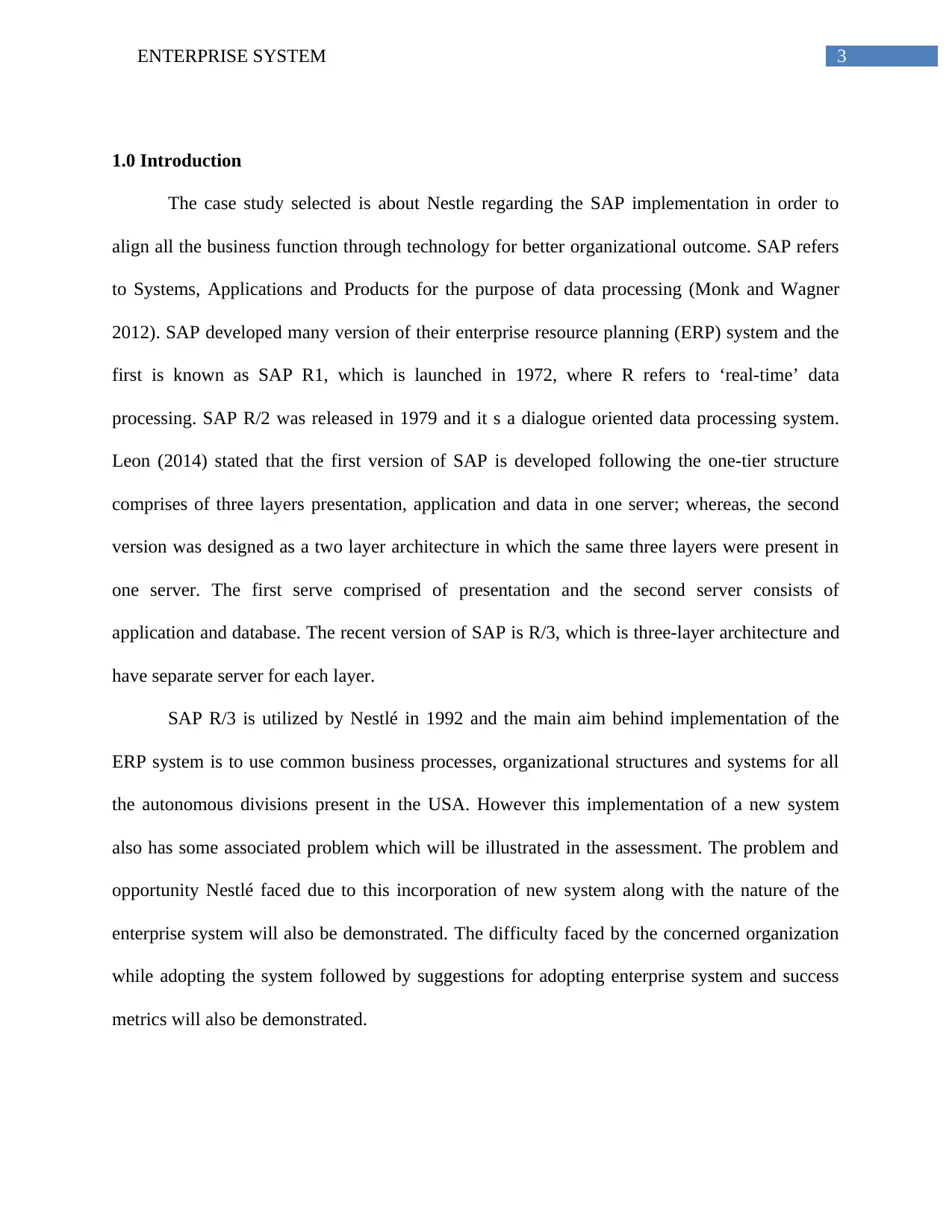
3ENTERPRISE SYSTEM
1.0 Introduction
The case study selected is about Nestle regarding the SAP implementation in order to
align all the business function through technology for better organizational outcome. SAP refers
to Systems, Applications and Products for the purpose of data processing (Monk and Wagner
2012). SAP developed many version of their enterprise resource planning (ERP) system and the
first is known as SAP R1, which is launched in 1972, where R refers to ‘real-time’ data
processing. SAP R/2 was released in 1979 and it s a dialogue oriented data processing system.
Leon (2014) stated that the first version of SAP is developed following the one-tier structure
comprises of three layers presentation, application and data in one server; whereas, the second
version was designed as a two layer architecture in which the same three layers were present in
one server. The first serve comprised of presentation and the second server consists of
application and database. The recent version of SAP is R/3, which is three-layer architecture and
have separate server for each layer.
SAP R/3 is utilized by Nestlé in 1992 and the main aim behind implementation of the
ERP system is to use common business processes, organizational structures and systems for all
the autonomous divisions present in the USA. However this implementation of a new system
also has some associated problem which will be illustrated in the assessment. The problem and
opportunity Nestlé faced due to this incorporation of new system along with the nature of the
enterprise system will also be demonstrated. The difficulty faced by the concerned organization
while adopting the system followed by suggestions for adopting enterprise system and success
metrics will also be demonstrated.
1.0 Introduction
The case study selected is about Nestle regarding the SAP implementation in order to
align all the business function through technology for better organizational outcome. SAP refers
to Systems, Applications and Products for the purpose of data processing (Monk and Wagner
2012). SAP developed many version of their enterprise resource planning (ERP) system and the
first is known as SAP R1, which is launched in 1972, where R refers to ‘real-time’ data
processing. SAP R/2 was released in 1979 and it s a dialogue oriented data processing system.
Leon (2014) stated that the first version of SAP is developed following the one-tier structure
comprises of three layers presentation, application and data in one server; whereas, the second
version was designed as a two layer architecture in which the same three layers were present in
one server. The first serve comprised of presentation and the second server consists of
application and database. The recent version of SAP is R/3, which is three-layer architecture and
have separate server for each layer.
SAP R/3 is utilized by Nestlé in 1992 and the main aim behind implementation of the
ERP system is to use common business processes, organizational structures and systems for all
the autonomous divisions present in the USA. However this implementation of a new system
also has some associated problem which will be illustrated in the assessment. The problem and
opportunity Nestlé faced due to this incorporation of new system along with the nature of the
enterprise system will also be demonstrated. The difficulty faced by the concerned organization
while adopting the system followed by suggestions for adopting enterprise system and success
metrics will also be demonstrated.
Secure Best Marks with AI Grader
Need help grading? Try our AI Grader for instant feedback on your assignments.
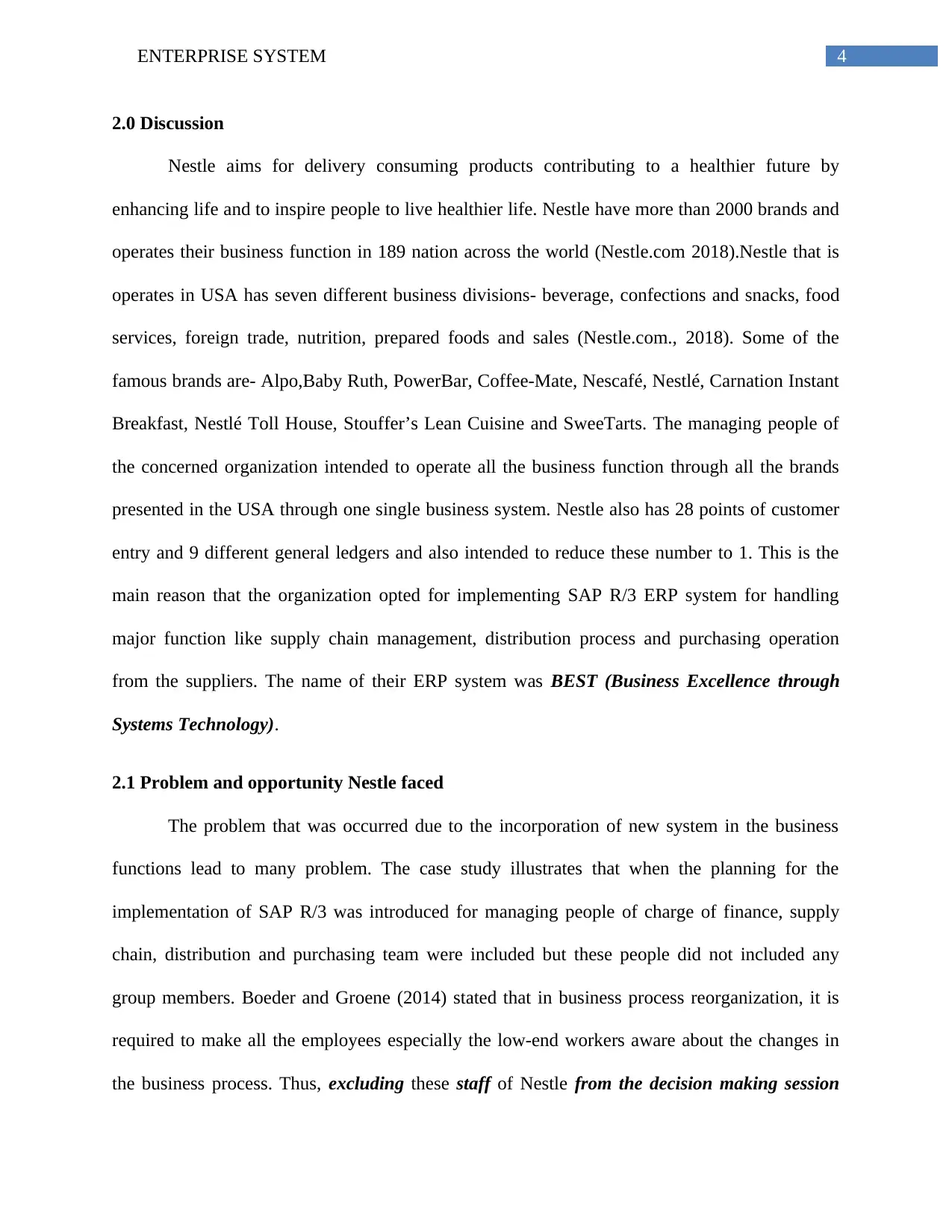
4ENTERPRISE SYSTEM
2.0 Discussion
Nestle aims for delivery consuming products contributing to a healthier future by
enhancing life and to inspire people to live healthier life. Nestle have more than 2000 brands and
operates their business function in 189 nation across the world (Nestle.com 2018).Nestle that is
operates in USA has seven different business divisions- beverage, confections and snacks, food
services, foreign trade, nutrition, prepared foods and sales (Nestle.com., 2018). Some of the
famous brands are- Alpo,Baby Ruth, PowerBar, Coffee-Mate, Nescafé, Nestlé, Carnation Instant
Breakfast, Nestlé Toll House, Stouffer’s Lean Cuisine and SweeTarts. The managing people of
the concerned organization intended to operate all the business function through all the brands
presented in the USA through one single business system. Nestle also has 28 points of customer
entry and 9 different general ledgers and also intended to reduce these number to 1. This is the
main reason that the organization opted for implementing SAP R/3 ERP system for handling
major function like supply chain management, distribution process and purchasing operation
from the suppliers. The name of their ERP system was BEST (Business Excellence through
Systems Technology).
2.1 Problem and opportunity Nestle faced
The problem that was occurred due to the incorporation of new system in the business
functions lead to many problem. The case study illustrates that when the planning for the
implementation of SAP R/3 was introduced for managing people of charge of finance, supply
chain, distribution and purchasing team were included but these people did not included any
group members. Boeder and Groene (2014) stated that in business process reorganization, it is
required to make all the employees especially the low-end workers aware about the changes in
the business process. Thus, excluding these staff of Nestle from the decision making session
2.0 Discussion
Nestle aims for delivery consuming products contributing to a healthier future by
enhancing life and to inspire people to live healthier life. Nestle have more than 2000 brands and
operates their business function in 189 nation across the world (Nestle.com 2018).Nestle that is
operates in USA has seven different business divisions- beverage, confections and snacks, food
services, foreign trade, nutrition, prepared foods and sales (Nestle.com., 2018). Some of the
famous brands are- Alpo,Baby Ruth, PowerBar, Coffee-Mate, Nescafé, Nestlé, Carnation Instant
Breakfast, Nestlé Toll House, Stouffer’s Lean Cuisine and SweeTarts. The managing people of
the concerned organization intended to operate all the business function through all the brands
presented in the USA through one single business system. Nestle also has 28 points of customer
entry and 9 different general ledgers and also intended to reduce these number to 1. This is the
main reason that the organization opted for implementing SAP R/3 ERP system for handling
major function like supply chain management, distribution process and purchasing operation
from the suppliers. The name of their ERP system was BEST (Business Excellence through
Systems Technology).
2.1 Problem and opportunity Nestle faced
The problem that was occurred due to the incorporation of new system in the business
functions lead to many problem. The case study illustrates that when the planning for the
implementation of SAP R/3 was introduced for managing people of charge of finance, supply
chain, distribution and purchasing team were included but these people did not included any
group members. Boeder and Groene (2014) stated that in business process reorganization, it is
required to make all the employees especially the low-end workers aware about the changes in
the business process. Thus, excluding these staff of Nestle from the decision making session
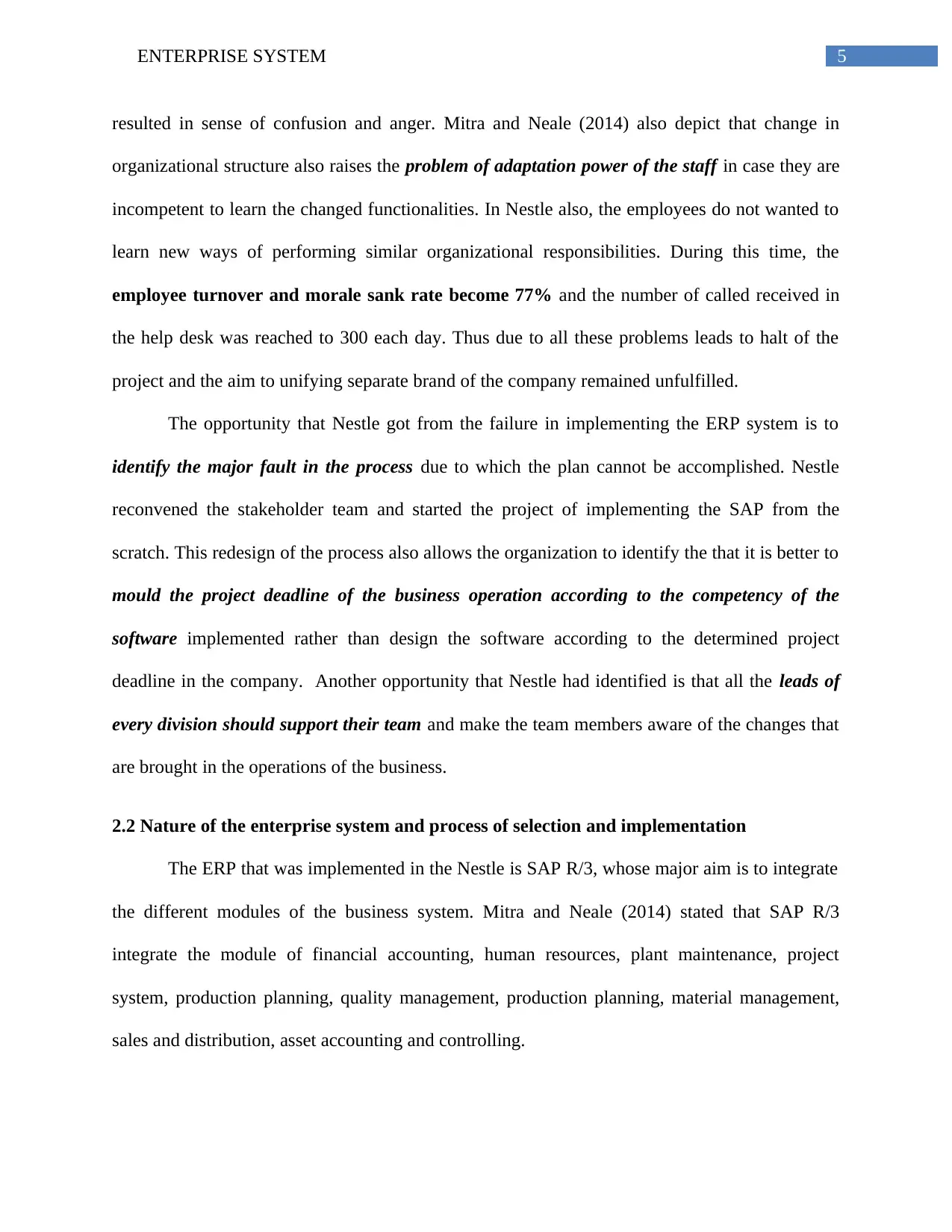
5ENTERPRISE SYSTEM
resulted in sense of confusion and anger. Mitra and Neale (2014) also depict that change in
organizational structure also raises the problem of adaptation power of the staff in case they are
incompetent to learn the changed functionalities. In Nestle also, the employees do not wanted to
learn new ways of performing similar organizational responsibilities. During this time, the
employee turnover and morale sank rate become 77% and the number of called received in
the help desk was reached to 300 each day. Thus due to all these problems leads to halt of the
project and the aim to unifying separate brand of the company remained unfulfilled.
The opportunity that Nestle got from the failure in implementing the ERP system is to
identify the major fault in the process due to which the plan cannot be accomplished. Nestle
reconvened the stakeholder team and started the project of implementing the SAP from the
scratch. This redesign of the process also allows the organization to identify the that it is better to
mould the project deadline of the business operation according to the competency of the
software implemented rather than design the software according to the determined project
deadline in the company. Another opportunity that Nestle had identified is that all the leads of
every division should support their team and make the team members aware of the changes that
are brought in the operations of the business.
2.2 Nature of the enterprise system and process of selection and implementation
The ERP that was implemented in the Nestle is SAP R/3, whose major aim is to integrate
the different modules of the business system. Mitra and Neale (2014) stated that SAP R/3
integrate the module of financial accounting, human resources, plant maintenance, project
system, production planning, quality management, production planning, material management,
sales and distribution, asset accounting and controlling.
resulted in sense of confusion and anger. Mitra and Neale (2014) also depict that change in
organizational structure also raises the problem of adaptation power of the staff in case they are
incompetent to learn the changed functionalities. In Nestle also, the employees do not wanted to
learn new ways of performing similar organizational responsibilities. During this time, the
employee turnover and morale sank rate become 77% and the number of called received in
the help desk was reached to 300 each day. Thus due to all these problems leads to halt of the
project and the aim to unifying separate brand of the company remained unfulfilled.
The opportunity that Nestle got from the failure in implementing the ERP system is to
identify the major fault in the process due to which the plan cannot be accomplished. Nestle
reconvened the stakeholder team and started the project of implementing the SAP from the
scratch. This redesign of the process also allows the organization to identify the that it is better to
mould the project deadline of the business operation according to the competency of the
software implemented rather than design the software according to the determined project
deadline in the company. Another opportunity that Nestle had identified is that all the leads of
every division should support their team and make the team members aware of the changes that
are brought in the operations of the business.
2.2 Nature of the enterprise system and process of selection and implementation
The ERP that was implemented in the Nestle is SAP R/3, whose major aim is to integrate
the different modules of the business system. Mitra and Neale (2014) stated that SAP R/3
integrate the module of financial accounting, human resources, plant maintenance, project
system, production planning, quality management, production planning, material management,
sales and distribution, asset accounting and controlling.

6ENTERPRISE SYSTEM
Image: Modules of SAP R/3
(Source: Mitra and Neale 2014)
In the year 2003, Nestle has given the project to design the ERP system for the
organization to IBM. It was a 5 year deal and the total cost of the project that Nestle paid to IBM
was $500 million. The main objective in this case is to reduce inventory and redistribution
expenses. According to the project plan, the developed system should align the server of
hardware, software and IT services with mySAP.com, which is an e-Business software system.
The designed system also comprised of internal portal that is access by each of the employee
through mySAP.com for performing their daily work responsibilities.
The implementation process of the developed EPR in the Nestle was done based on the
fact on how the developed software takes time to accomplish business functions by not trying to
mould the business function behave like the developed software. Nestle have also chosen their
Image: Modules of SAP R/3
(Source: Mitra and Neale 2014)
In the year 2003, Nestle has given the project to design the ERP system for the
organization to IBM. It was a 5 year deal and the total cost of the project that Nestle paid to IBM
was $500 million. The main objective in this case is to reduce inventory and redistribution
expenses. According to the project plan, the developed system should align the server of
hardware, software and IT services with mySAP.com, which is an e-Business software system.
The designed system also comprised of internal portal that is access by each of the employee
through mySAP.com for performing their daily work responsibilities.
The implementation process of the developed EPR in the Nestle was done based on the
fact on how the developed software takes time to accomplish business functions by not trying to
mould the business function behave like the developed software. Nestle have also chosen their
Paraphrase This Document
Need a fresh take? Get an instant paraphrase of this document with our AI Paraphraser

7ENTERPRISE SYSTEM
ERP package by making IBM clear about their requirements. Nestle did not relied on the demo
version of any ERP system. Nestle did not focused on heavy customization of the ERP
implementation in the business. Karduck and Tumer (2012) stated that heavy customization
makes the project deadline extended much which might be impacted the business result in a
negative way like high maintenance cost of the system. Akinsolu (2013) highlight another
problem that is high customized might help the organization to perform their business functions
differently but all the service providers might not be aware of the system the organization is
adapting. This make the improvement time of the system grater as the provider of not the
previous ne come to make amendments in the developed software system.
2.3 Difficulties Nestle faced in adopting the system
There are many problems that Nestle had faced after the implementation of the project.
The first problem was not providing staff training to any staff when a changed system was
introduced. This lead to dissatisfaction among the employees and as a result their performance
during the change system was poor. Mitra (2012) stated that during the change management,
people in company feel fear for whether not they can manage the change and perform well
through the new system. Singhla (2014) furthermore stated that some of the employee developed
the fear that they could be replaced by the technology have to lost their jobs. In Nestle, employee
are not introduced with change system prior in the implementing sessions due to which
employees did not understand how to use the new system and they were forced to adopt the
changed system. Another problem that the company faced is the technical difficulties. Kalaimani
(2016) stated that every hardware and software system has some limitations which should be
known by the users so that they can accomplish this system with the proper knowledge of the
limitation. In case of Nestle, employees of the company intends to o beat the Y2K deadline the
ERP package by making IBM clear about their requirements. Nestle did not relied on the demo
version of any ERP system. Nestle did not focused on heavy customization of the ERP
implementation in the business. Karduck and Tumer (2012) stated that heavy customization
makes the project deadline extended much which might be impacted the business result in a
negative way like high maintenance cost of the system. Akinsolu (2013) highlight another
problem that is high customized might help the organization to perform their business functions
differently but all the service providers might not be aware of the system the organization is
adapting. This make the improvement time of the system grater as the provider of not the
previous ne come to make amendments in the developed software system.
2.3 Difficulties Nestle faced in adopting the system
There are many problems that Nestle had faced after the implementation of the project.
The first problem was not providing staff training to any staff when a changed system was
introduced. This lead to dissatisfaction among the employees and as a result their performance
during the change system was poor. Mitra (2012) stated that during the change management,
people in company feel fear for whether not they can manage the change and perform well
through the new system. Singhla (2014) furthermore stated that some of the employee developed
the fear that they could be replaced by the technology have to lost their jobs. In Nestle, employee
are not introduced with change system prior in the implementing sessions due to which
employees did not understand how to use the new system and they were forced to adopt the
changed system. Another problem that the company faced is the technical difficulties. Kalaimani
(2016) stated that every hardware and software system has some limitations which should be
known by the users so that they can accomplish this system with the proper knowledge of the
limitation. In case of Nestle, employees of the company intends to o beat the Y2K deadline the
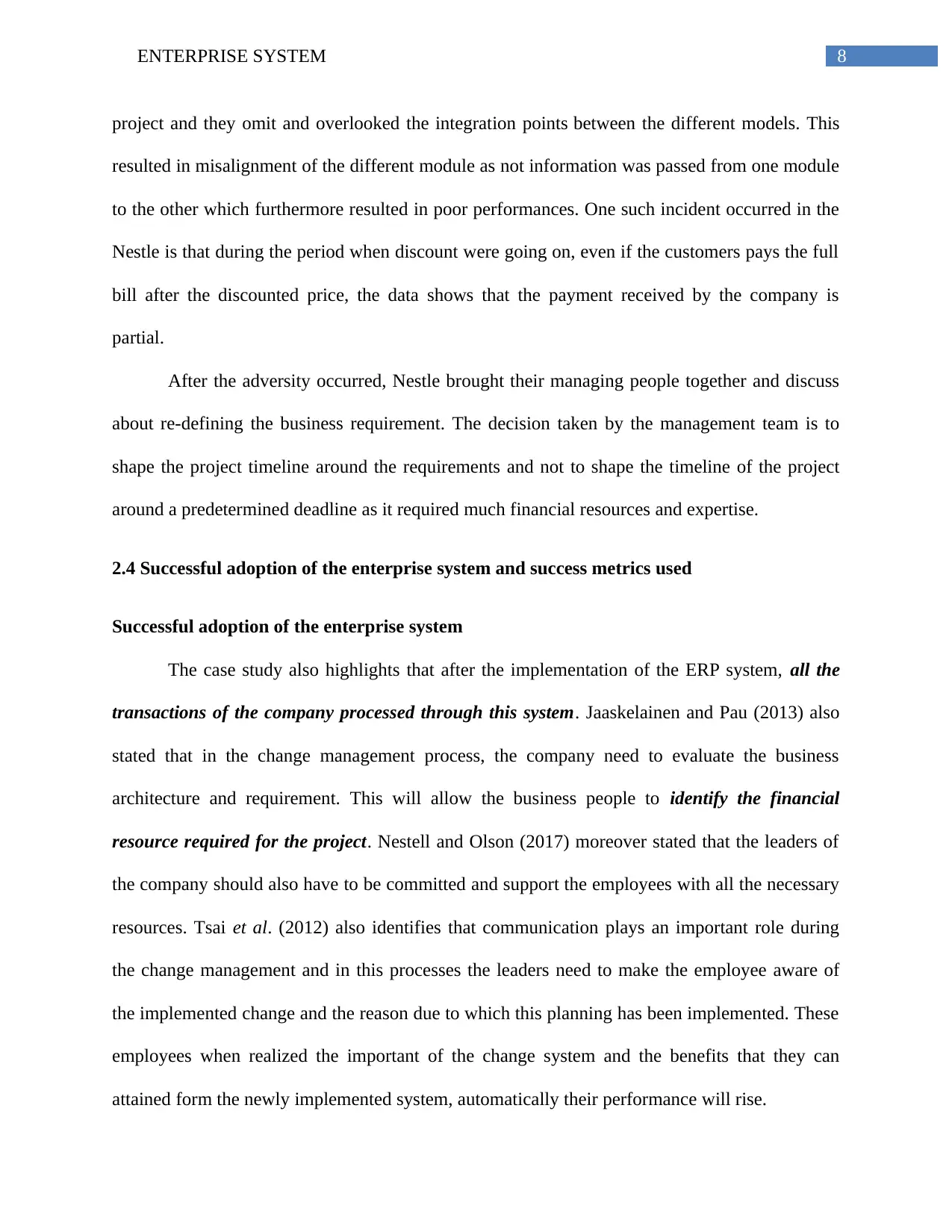
8ENTERPRISE SYSTEM
project and they omit and overlooked the integration points between the different models. This
resulted in misalignment of the different module as not information was passed from one module
to the other which furthermore resulted in poor performances. One such incident occurred in the
Nestle is that during the period when discount were going on, even if the customers pays the full
bill after the discounted price, the data shows that the payment received by the company is
partial.
After the adversity occurred, Nestle brought their managing people together and discuss
about re-defining the business requirement. The decision taken by the management team is to
shape the project timeline around the requirements and not to shape the timeline of the project
around a predetermined deadline as it required much financial resources and expertise.
2.4 Successful adoption of the enterprise system and success metrics used
Successful adoption of the enterprise system
The case study also highlights that after the implementation of the ERP system, all the
transactions of the company processed through this system. Jaaskelainen and Pau (2013) also
stated that in the change management process, the company need to evaluate the business
architecture and requirement. This will allow the business people to identify the financial
resource required for the project. Nestell and Olson (2017) moreover stated that the leaders of
the company should also have to be committed and support the employees with all the necessary
resources. Tsai et al. (2012) also identifies that communication plays an important role during
the change management and in this processes the leaders need to make the employee aware of
the implemented change and the reason due to which this planning has been implemented. These
employees when realized the important of the change system and the benefits that they can
attained form the newly implemented system, automatically their performance will rise.
project and they omit and overlooked the integration points between the different models. This
resulted in misalignment of the different module as not information was passed from one module
to the other which furthermore resulted in poor performances. One such incident occurred in the
Nestle is that during the period when discount were going on, even if the customers pays the full
bill after the discounted price, the data shows that the payment received by the company is
partial.
After the adversity occurred, Nestle brought their managing people together and discuss
about re-defining the business requirement. The decision taken by the management team is to
shape the project timeline around the requirements and not to shape the timeline of the project
around a predetermined deadline as it required much financial resources and expertise.
2.4 Successful adoption of the enterprise system and success metrics used
Successful adoption of the enterprise system
The case study also highlights that after the implementation of the ERP system, all the
transactions of the company processed through this system. Jaaskelainen and Pau (2013) also
stated that in the change management process, the company need to evaluate the business
architecture and requirement. This will allow the business people to identify the financial
resource required for the project. Nestell and Olson (2017) moreover stated that the leaders of
the company should also have to be committed and support the employees with all the necessary
resources. Tsai et al. (2012) also identifies that communication plays an important role during
the change management and in this processes the leaders need to make the employee aware of
the implemented change and the reason due to which this planning has been implemented. These
employees when realized the important of the change system and the benefits that they can
attained form the newly implemented system, automatically their performance will rise.

9ENTERPRISE SYSTEM
Nestle USA claimed that they saved over $325 million and the areas from which this
savings has been made is in supply chain improvements as the ERP system allow the company to
forecast the demand. Initially this has been done through a sale person, who was recruited to give
the number of the total number of users opted for a particular Nestle products to the demand
planner. The problem arise when Nestle’s management people cross-checked the value given by
the sales person with the factory manager and both the value found to be contradicted. Thus, this
frequent change in number delays the demand forecasting method. The SAP implemented
utilizes the common databases and business processes which not only make the process of
demand forecasting faster but also presented an accurate update regarding the orders purchased
and demanded by the users. The similar database system helps the organization to maintain the
raw materials purchase from the supplier in a similar way and simplified the operating
procedures along with centralization of functions. The company also benefited through training
programs that is same for all the locations as all the location follows a similar procedure to
accomplish the business functionality.
Success metric used by the Nestle
Technical Failures- The problem of lack of misalignment of the databases occurred in
Nestle’s account department reduced. Earlier when employees at the cash counter take the
payment from the user at a discounted amount, the data were not updates in the account database
in the older times. As a result, the later database showed that user has made a particle payment
for their purchase. This problem gets resolved as all the databases are linked after the redesign of
the ERP system.
Employee engagement- As mentioned above that during the change management, many
employees have the fear of losing jobs ad have low self confidence in utilizing their potential to
Nestle USA claimed that they saved over $325 million and the areas from which this
savings has been made is in supply chain improvements as the ERP system allow the company to
forecast the demand. Initially this has been done through a sale person, who was recruited to give
the number of the total number of users opted for a particular Nestle products to the demand
planner. The problem arise when Nestle’s management people cross-checked the value given by
the sales person with the factory manager and both the value found to be contradicted. Thus, this
frequent change in number delays the demand forecasting method. The SAP implemented
utilizes the common databases and business processes which not only make the process of
demand forecasting faster but also presented an accurate update regarding the orders purchased
and demanded by the users. The similar database system helps the organization to maintain the
raw materials purchase from the supplier in a similar way and simplified the operating
procedures along with centralization of functions. The company also benefited through training
programs that is same for all the locations as all the location follows a similar procedure to
accomplish the business functionality.
Success metric used by the Nestle
Technical Failures- The problem of lack of misalignment of the databases occurred in
Nestle’s account department reduced. Earlier when employees at the cash counter take the
payment from the user at a discounted amount, the data were not updates in the account database
in the older times. As a result, the later database showed that user has made a particle payment
for their purchase. This problem gets resolved as all the databases are linked after the redesign of
the ERP system.
Employee engagement- As mentioned above that during the change management, many
employees have the fear of losing jobs ad have low self confidence in utilizing their potential to
Secure Best Marks with AI Grader
Need help grading? Try our AI Grader for instant feedback on your assignments.

10ENTERPRISE SYSTEM
adopt new system. However, the training process provided to all the employees regarding the
new system and the procedure to use the same, allow the organization to retain their employees.
Saving financial resources- Over $325 million was saved in the year 2002 after the
implementation of the ERP system. The incorporation of the SAP ERP in the existing system
helps Nestle to save money in some of the departments especially in supply chain management
and distribution process. Thus, Nestle also focus on profit over revenue for each passing year
that they have attained trough the ERP system.
Conversion Rate- The successful implementation of the system helps the organization to
forecast the demand for certain products accurately. Thus, Nestle can use the system for
manufacturing the high demanded products more to increase the conversion rate. Thus, it can be
said that the higher number of customers or user need is also a success metrics that Nestle
utilized.
3.0 Conclusion
Thus, it can be said that the implementation process of the SAP ERP contain both the
aspects of failure and success. It can be concluded that the management need to be collaborative
in the initial phase and if the employees are forced to adopt the changed system the project might
be rolled out. It is practically difficult to redesign work processes without the involvement of the
low level employees. Thus, support from the management is necessary as they are the one who
can make the employee learnt about the advantage of the newly implemented system. Another
aspect that can be learnt from the case of Nestle is that the new design of the ERP system should
not be forced to be completed within the given time limit of existing projects. This will lead to
improper design of the customized system and overlooking of some crucial parts of the software
in order to match the project requirement. It is found from the case study that it is better to
adopt new system. However, the training process provided to all the employees regarding the
new system and the procedure to use the same, allow the organization to retain their employees.
Saving financial resources- Over $325 million was saved in the year 2002 after the
implementation of the ERP system. The incorporation of the SAP ERP in the existing system
helps Nestle to save money in some of the departments especially in supply chain management
and distribution process. Thus, Nestle also focus on profit over revenue for each passing year
that they have attained trough the ERP system.
Conversion Rate- The successful implementation of the system helps the organization to
forecast the demand for certain products accurately. Thus, Nestle can use the system for
manufacturing the high demanded products more to increase the conversion rate. Thus, it can be
said that the higher number of customers or user need is also a success metrics that Nestle
utilized.
3.0 Conclusion
Thus, it can be said that the implementation process of the SAP ERP contain both the
aspects of failure and success. It can be concluded that the management need to be collaborative
in the initial phase and if the employees are forced to adopt the changed system the project might
be rolled out. It is practically difficult to redesign work processes without the involvement of the
low level employees. Thus, support from the management is necessary as they are the one who
can make the employee learnt about the advantage of the newly implemented system. Another
aspect that can be learnt from the case of Nestle is that the new design of the ERP system should
not be forced to be completed within the given time limit of existing projects. This will lead to
improper design of the customized system and overlooking of some crucial parts of the software
in order to match the project requirement. It is found from the case study that it is better to
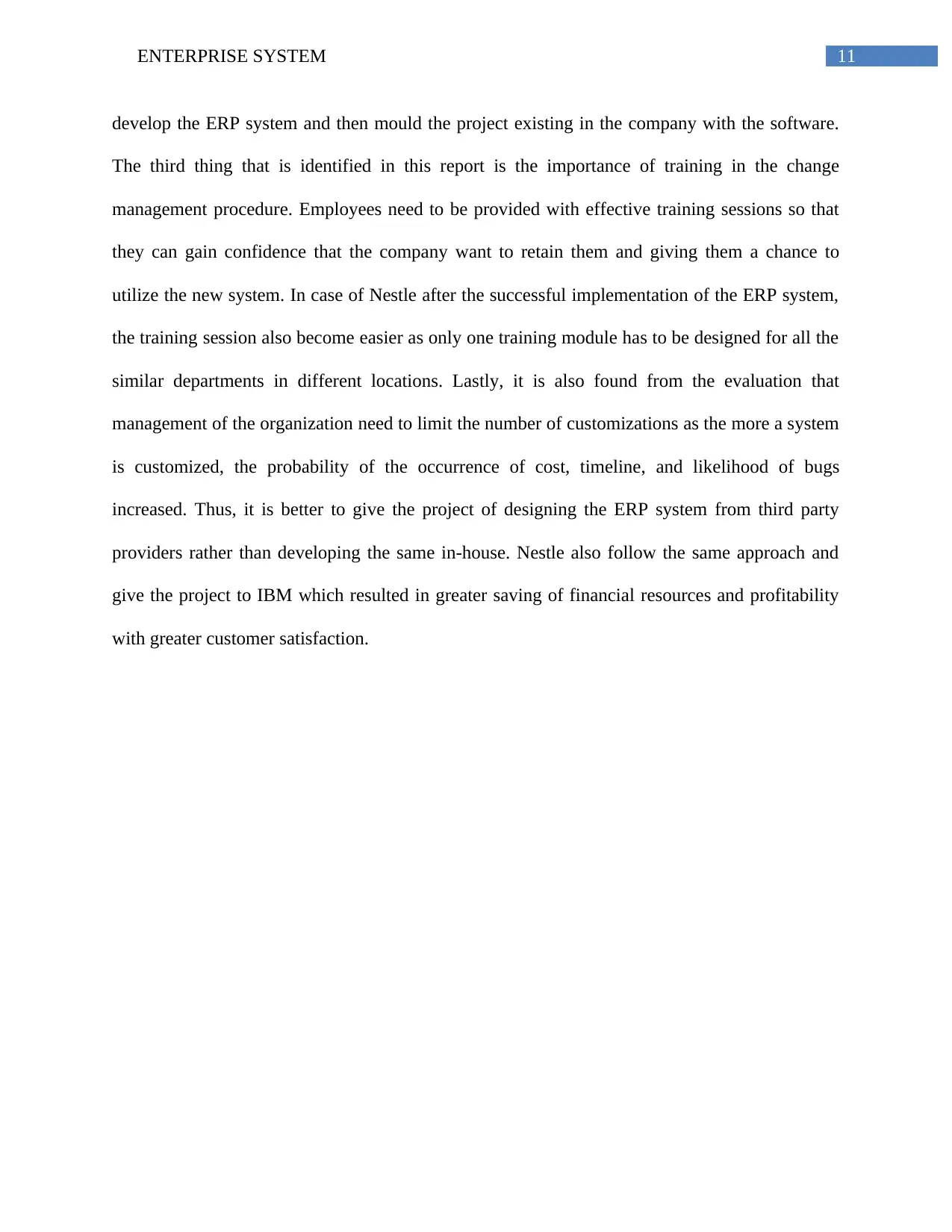
11ENTERPRISE SYSTEM
develop the ERP system and then mould the project existing in the company with the software.
The third thing that is identified in this report is the importance of training in the change
management procedure. Employees need to be provided with effective training sessions so that
they can gain confidence that the company want to retain them and giving them a chance to
utilize the new system. In case of Nestle after the successful implementation of the ERP system,
the training session also become easier as only one training module has to be designed for all the
similar departments in different locations. Lastly, it is also found from the evaluation that
management of the organization need to limit the number of customizations as the more a system
is customized, the probability of the occurrence of cost, timeline, and likelihood of bugs
increased. Thus, it is better to give the project of designing the ERP system from third party
providers rather than developing the same in-house. Nestle also follow the same approach and
give the project to IBM which resulted in greater saving of financial resources and profitability
with greater customer satisfaction.
develop the ERP system and then mould the project existing in the company with the software.
The third thing that is identified in this report is the importance of training in the change
management procedure. Employees need to be provided with effective training sessions so that
they can gain confidence that the company want to retain them and giving them a chance to
utilize the new system. In case of Nestle after the successful implementation of the ERP system,
the training session also become easier as only one training module has to be designed for all the
similar departments in different locations. Lastly, it is also found from the evaluation that
management of the organization need to limit the number of customizations as the more a system
is customized, the probability of the occurrence of cost, timeline, and likelihood of bugs
increased. Thus, it is better to give the project of designing the ERP system from third party
providers rather than developing the same in-house. Nestle also follow the same approach and
give the project to IBM which resulted in greater saving of financial resources and profitability
with greater customer satisfaction.
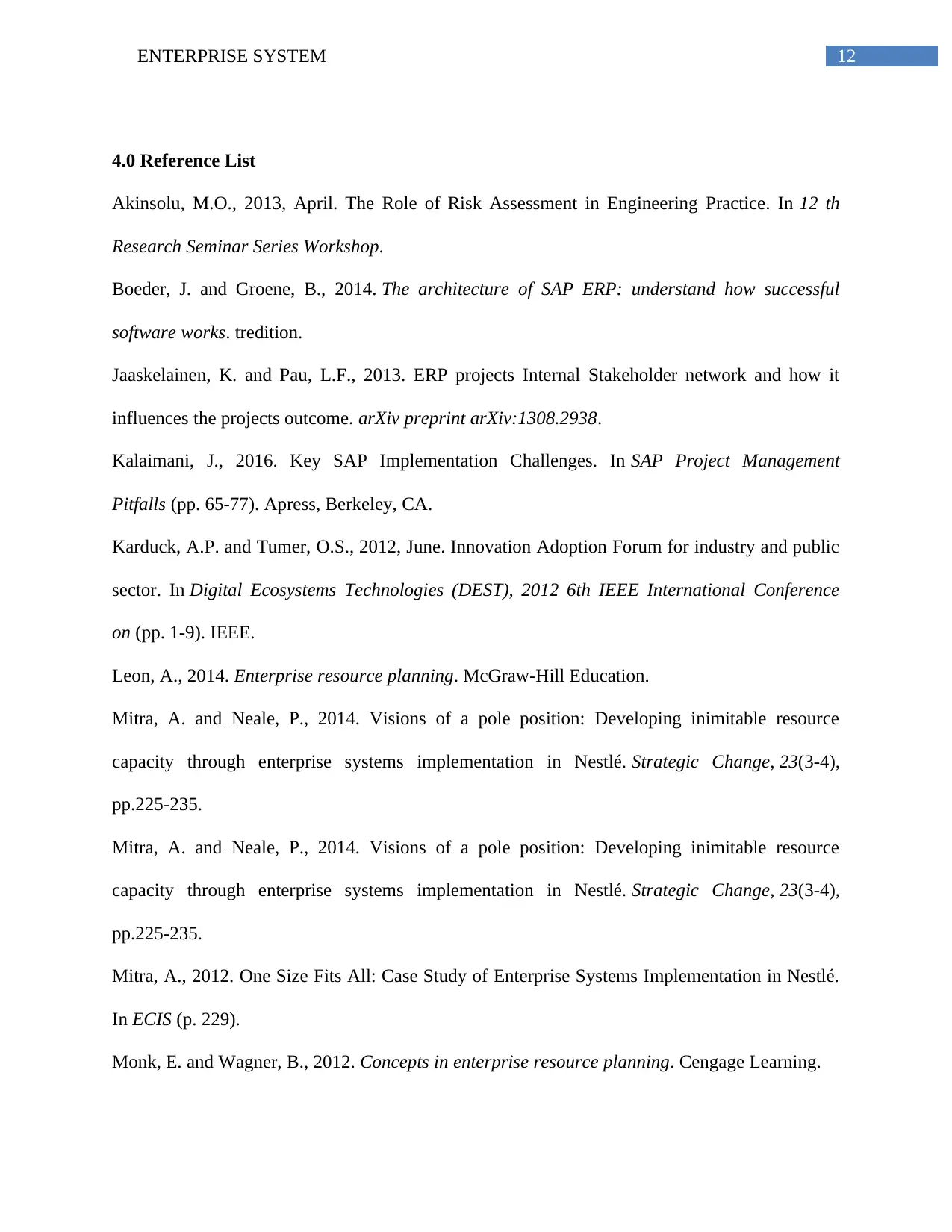
12ENTERPRISE SYSTEM
4.0 Reference List
Akinsolu, M.O., 2013, April. The Role of Risk Assessment in Engineering Practice. In 12 th
Research Seminar Series Workshop.
Boeder, J. and Groene, B., 2014. The architecture of SAP ERP: understand how successful
software works. tredition.
Jaaskelainen, K. and Pau, L.F., 2013. ERP projects Internal Stakeholder network and how it
influences the projects outcome. arXiv preprint arXiv:1308.2938.
Kalaimani, J., 2016. Key SAP Implementation Challenges. In SAP Project Management
Pitfalls (pp. 65-77). Apress, Berkeley, CA.
Karduck, A.P. and Tumer, O.S., 2012, June. Innovation Adoption Forum for industry and public
sector. In Digital Ecosystems Technologies (DEST), 2012 6th IEEE International Conference
on (pp. 1-9). IEEE.
Leon, A., 2014. Enterprise resource planning. McGraw-Hill Education.
Mitra, A. and Neale, P., 2014. Visions of a pole position: Developing inimitable resource
capacity through enterprise systems implementation in Nestlé. Strategic Change, 23(3-4),
pp.225-235.
Mitra, A. and Neale, P., 2014. Visions of a pole position: Developing inimitable resource
capacity through enterprise systems implementation in Nestlé. Strategic Change, 23(3-4),
pp.225-235.
Mitra, A., 2012. One Size Fits All: Case Study of Enterprise Systems Implementation in Nestlé.
In ECIS (p. 229).
Monk, E. and Wagner, B., 2012. Concepts in enterprise resource planning. Cengage Learning.
4.0 Reference List
Akinsolu, M.O., 2013, April. The Role of Risk Assessment in Engineering Practice. In 12 th
Research Seminar Series Workshop.
Boeder, J. and Groene, B., 2014. The architecture of SAP ERP: understand how successful
software works. tredition.
Jaaskelainen, K. and Pau, L.F., 2013. ERP projects Internal Stakeholder network and how it
influences the projects outcome. arXiv preprint arXiv:1308.2938.
Kalaimani, J., 2016. Key SAP Implementation Challenges. In SAP Project Management
Pitfalls (pp. 65-77). Apress, Berkeley, CA.
Karduck, A.P. and Tumer, O.S., 2012, June. Innovation Adoption Forum for industry and public
sector. In Digital Ecosystems Technologies (DEST), 2012 6th IEEE International Conference
on (pp. 1-9). IEEE.
Leon, A., 2014. Enterprise resource planning. McGraw-Hill Education.
Mitra, A. and Neale, P., 2014. Visions of a pole position: Developing inimitable resource
capacity through enterprise systems implementation in Nestlé. Strategic Change, 23(3-4),
pp.225-235.
Mitra, A. and Neale, P., 2014. Visions of a pole position: Developing inimitable resource
capacity through enterprise systems implementation in Nestlé. Strategic Change, 23(3-4),
pp.225-235.
Mitra, A., 2012. One Size Fits All: Case Study of Enterprise Systems Implementation in Nestlé.
In ECIS (p. 229).
Monk, E. and Wagner, B., 2012. Concepts in enterprise resource planning. Cengage Learning.
Paraphrase This Document
Need a fresh take? Get an instant paraphrase of this document with our AI Paraphraser

13ENTERPRISE SYSTEM
Nestell, J.G. and Olson, D.L., 2017. Successful ERP Systems: A Guide for Businesses and
Executives. Business Expert Press.
Nestle.com., 2018. About Us. [online] Available at: https://www.nestle.com/aboutus [Accessed
214 May 2018].
Singhla, J., 2014. Challenges in implementation of enterprise resource planning in india: a case
study of corps of electronics and mechanical engineers: EME.
Tsai, W.H., Lee, P.L., Shen, Y.S. and Lin, H.L., 2012. A comprehensive study of the relationship
between enterprise resource planning selection criteria and enterprise resource planning system
success. Information & Management, 49(1), pp.36-46.
Nestell, J.G. and Olson, D.L., 2017. Successful ERP Systems: A Guide for Businesses and
Executives. Business Expert Press.
Nestle.com., 2018. About Us. [online] Available at: https://www.nestle.com/aboutus [Accessed
214 May 2018].
Singhla, J., 2014. Challenges in implementation of enterprise resource planning in india: a case
study of corps of electronics and mechanical engineers: EME.
Tsai, W.H., Lee, P.L., Shen, Y.S. and Lin, H.L., 2012. A comprehensive study of the relationship
between enterprise resource planning selection criteria and enterprise resource planning system
success. Information & Management, 49(1), pp.36-46.
1 out of 14
Related Documents
Your All-in-One AI-Powered Toolkit for Academic Success.
+13062052269
info@desklib.com
Available 24*7 on WhatsApp / Email
![[object Object]](/_next/static/media/star-bottom.7253800d.svg)
Unlock your academic potential
© 2024 | Zucol Services PVT LTD | All rights reserved.





